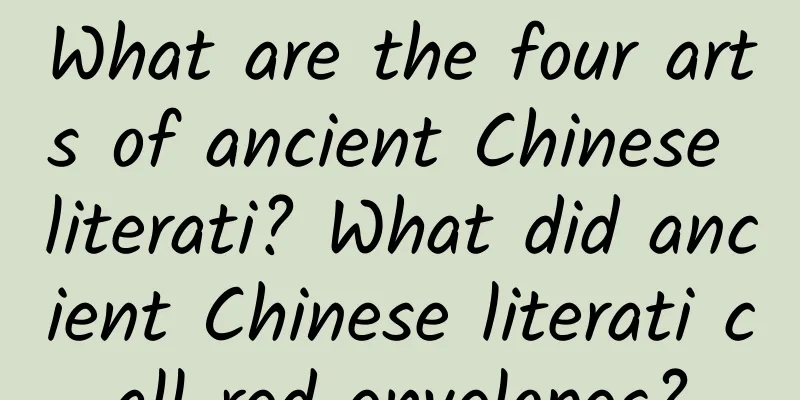What are the four arts of ancient Chinese literati? What did ancient Chinese literati call red envelopes?

|
The lessons and summaries of our predecessors in the pursuit process are actually what we can learn and draw lessons from, so that we, or later generations, can take fewer detours when pursuing, so that we, our descendants, can pursue it earlier. Many literati pursue harmony in life, which actually reflects the harmonious rules of our world. Many disharmony will eventually return to harmony. So what are the four arts of ancient Chinese literati? What did ancient Chinese literati call red envelopes? Let's take a look at the introduction of Encyclopedia Knowledge Network! Contents of this article 1. What are the four arts of ancient Chinese literati? 2. What did ancient Chinese scholars call red envelopes? 3. Ask for the ancient literati's name 1What are the four arts of ancient Chinese literati?The traditional four arts usually refer to the four elegant arts that Chinese literati admire and master, namely, zither, chess, calligraphy, and painting. These four arts are called "the four arts of literati" or "the four arts of scholars". Qin, chess, calligraphy and painting are the spiritual sustenance of the ancients to cultivate their moral character beyond the mundane world. They embody the beauty, nobility and wisdom of the world and pursue the realm of "harmony between man and nature" and "the sameness of heaven and earth". It is the legacy of these literary and artistic forms that allows modern people to touch the profound and broad cultural heritage of ancient China. Qin, chess, calligraphy and painting are also the artistic life content of Chinese literati. As the first of the four arts, the guqin carries many cultural factors, and chess, calligraphy and painting also have their wonderful charm to render Chinese culture. 2What did ancient Chinese scholars call red envelopes?1. Red envelopes, also known as red envelopes and red bags. They first became popular in the Western Han Dynasty and were called "money for winning" and "flower money". This kind of money is not a currency circulating on the market. It is a kind of evil-avoiding item specially cast in the shape of coins for wearing and appreciation. The front of this coin is cast with words and various auspicious words, such as "Long Live the Emperor", "Peace in the World", "Get Rid of Disasters and Eliminate Evil", etc.; the back is cast with various patterns, such as dragons and phoenixes, turtles and snakes, Pisces, swords, stars, etc. This is equivalent to the auspicious gifts given to each other by relatives and friends nowadays, and cannot be used to buy things. 2. The evolution of red envelopes: In the Ming and Qing dynasties, most of the New Year's money was given to children with red strings. After the Republic of China, it evolved into being wrapped in red paper. Now it generally refers to a red paper package containing money; it is used to give gifts during celebrations. In the Cantonese-speaking areas of China, red envelopes are called "lishi", which is a gift made by placing money in a red envelope. 3Ask for ancient literati's nameAncient literati font size: In ancient times, most literati had a name, a courtesy name, and a pseudonym. Generally speaking, it is appropriate to use the courtesy name or courtesy name to honor ancestors; peers should call each other by courtesy names, not by personal names; when addressing younger or inferior people, one should use their personal names when referring to themselves or those who are humble. In addition, the names and courtesy names of ancient people were mostly closely related. |
Recommend
What causes vulvar itching, redness and swelling?
Generally speaking, itching and redness of the fe...
Things to note on the first day of cesarean section
Caesarean section is a method of delivery, but th...
What is the connection between the female uterus and ovaries?
Many of us know that women have uteruses and ovar...
Take good care of yourself during the "Three Nines" and you will be healthy in the coming year! These health tips are simple and practical
As the saying goes, "Replenish your body in ...
How to maintain your uterus after 30 years old?
It is said that time makes people grow old, espec...
Treatment of fibrocystic breast cancer
For the disease of fibrocystic breast hyperplasia...
Is it normal for a woolen coat to have a pungent smell? How to remove the pungent smell of a woolen coat?
Woolen coats are one of the must-have items in th...
8 reasons why women have stomach pain
Many women often suffer from stomach pain on week...
Why do I sweat between my breasts?
In many cases, people will experience chest sweat...
Why do women have swollen and painful breasts?
Breast health issues are something that all women...
What is the best way to quench your thirst in summer? Not iced cola, not water, but...
In recent days, some areas have experienced high ...
What are the hairstyles suitable for girls with big faces?
Girls all love beauty very much, and they are ver...
What brand of kitchen faucet is good? What are the tips for choosing kitchen faucets?
In our daily life, kitchen faucets can be said to...
Why do women need to have an IUD?
Women's physiological characteristics are ver...
What is the best breakfast? Can protein powder be eaten for breakfast?
Breakfast is not only necessary, but also nutriti...









